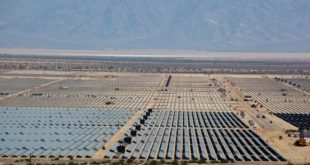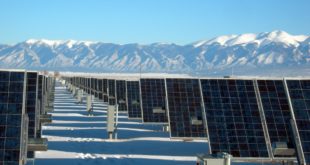The Top 10 predictions for the global photovoltaic market in 2013, from the IHS Solar service at information and analytics provider IHS.

“The photovoltaic industry is in the midst of wrenching change—buffeted by government incentive cuts and nose-diving prices that has hurt solar suppliers worldwide, rocked by trade disputes among its major players, and hamstrung by a sputtering global economy,” said Ash Sharma, director, solar research at IHS. “However, there are some bright spots ahead: Solar installations are on the rise, technology is becoming more efficient, and a weak EU market roiled by financial turmoil will be offset by an ascendant China and the United States.”
Below are the top 10 predictions for 2013 from the IHS solar research team.
1. The global PV market will achieve double-digit installation growth in 2013, but market revenue will fall to $75 billion. Industry revenues—measured as system prices multiplied by total gigawatts installed—peaked at $94 billion in 2011, but fell sharply to $77 billion in 2012, as presented in the figure below. Revenue is projected to decline once again in 2013 to $75 billion, on the back of lower volume growth and continued system price declines, given that PV component prices continue to fall.
2. The solar module industry will consolidate further in 2013. As 2012 comes to a close, fewer than 150 companies will remain in the photovoltaic upstream value chain, down from more than 750 companies in 2010. Most of the consolidation will involve companies going out of business entirely. Many integrated players, particularly those based in China, will fold up shop in 2013. The large expense of building and then operating integrated facilities that are underutilized will be more than many can handle financially.
3. PV module prices will stabilize in 2H 2013 as oversupply eases. Despite a drastic decline in prices along the silicon supply chain since March 2011, solar prices will stabilize by mid-2013. Changes in market dynamics will help restore the global supply-demand balance.
4. Solar trade wars will rage on in 2013, yielding few winners. As of November 2012, there were six different solar trade cases proceeding involving China, Europe, the United States and India. This cycle of sanction and retaliation will not help solve the fundamental challenge of overcapacity plaguing the global PV industry.
5. South Africa and Romania will emerge as PV markets to watch in 2013. The two countries next year will expand from virtually no solar installations to capacity of several hundred megawatts. The PV uptake in both markets is driven by distinct factors. In South Africa, PV additions will mainly stem from the tenders awarded in 2012; in Romania, the growth driver will be a green certificate (GC) scheme that will stay in place until 2014.
6. Double-digit returns remain possible for European PV projects in 2013. With the subsidy schemes that are currently in place, all EU countries continue to offer attractive conditions for both private and institutional investors. Meanwhile, an evaluation of no-incentive scenarios shows that the most mature market segments are on the cusp of grid parity, allowing healthy returns on investment.
7. solar energy” target=”_blank”>Solar will surpass wind in the United States. The year 2013 marks an important milestone, representing the first time that new U.S. solar PV capacity additions will be greater than those made by wind. This is partly a result of the near-term uncertainty over the federal production tax credit for wind. However, it is also a reflection of solar PV’s increasing competitiveness as a form of renewable power generation in some key U.S. markets.
8. China will become the world’s largest PV market. Total PV installations in China next year are predicted to surpass 6 gigawatts, allowing the country to surpass Germany as the No. 1 solar market on the planet.
9. Energy storage will transform the solar industry. Batteries increasingly are being seen as an attractive way of retaining PV electricity, letting people use the power later in the day to avoid paying high prices for electricity from the grid. Next year IHS forecasts a big jump in the number of residential PV systems installed with batteries attached.
10. New technology will revive equipment vendors’ prospects. Improved technologies will help PV manufacturers cut costs, increase margins and ultimately distinguish themselves from the competition. Such a focus creates an opportunity for both manufacturers and equipment suppliers to obtain larger revenue streams.
An extensive whitepaper with more details on each of the top 10 predictions for the solar industry from IHS can be downloaded here.

 Alternative Energy HQ solar power for homes, wind energy, and bio fuel issues
Alternative Energy HQ solar power for homes, wind energy, and bio fuel issues









